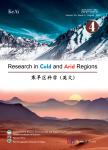Current climate change effects on the ground thermal regime in Central Yakutia
Current climate change effects on the ground thermal regime in Central Yakutia作者机构:Melnikov Permafrost Institute Siberian Branch of the Russian Academy of Sciences
出 版 物:《Research in Cold and Arid Regions》 (寒旱区科学(英文版))
年 卷 期:2014年第6卷第4期
页 面:282-292页
核心收录:
学科分类:07[理学] 070601[理学-气象学] 0705[理学-地理学] 070501[理学-自然地理学] 0706[理学-大气科学]
基 金:supported from grants of the Siberian branch, Russian Academy of Sciences the grant of the Russian Fund for Fundamental Research, project 01-05-96207 projects (Nos. 72, 1.9.10, 588, 1090) by state order of the Sakha Republic (Yakutia)
主 题:permafrost active layer climate ground temperature regime natural landscapes disturbed landscapes
摘 要:The evolution of ground thermal state has been studied to assess impacts of current climatic warming on permafrost in Central Yakutia. The analysis of long-term data of regional weather stations has revealed one of the highest increasing trends in mean annual air temperature in northern Russia. A forecast of surface air temperature fluctuations has been made by applying a frequency analysis method. Monitoring of ground thermal conditions allows us to identify inter-annual and long-term variability among a wide range of natural conditions. Experimental research has indicated a long-term dynamics of ground thermal state evolution: ground temperatures at the depth of zero annual amplitude and seasonally thawed layer depth. Long-term variability of thaw depth shows near-zero to weak positive trends in small valleys in contrast to weak negative trends on slopes. With significant climatic warming, the thermal state of near-surface layers of permafrost demonstrates steadiness. Anthropogenic impacts on ground thermal regime in various terrain types have been qualitatively evaluated. Clear-cutting, ground cover stripping, and post-fire deforestation in inter-alas type terrains result in a significant increase of temperature and seasonal ground thaw depth, as well as adverse cryogenic processes. The dynamics of mean annual ground temperature in slash and burn sites have been evaluated in reference to stages of successive vegetation recovery.



